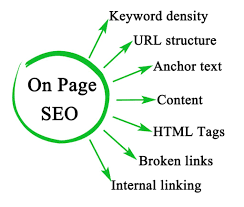How SEO Works: A Simple Guide to Search Engine Optimization

If you’ve ever wondered how websites appear at the top of Google search results, the answer is SEO – Search Engine Optimization.
SEO is the process of improving your website so that it ranks higher in search engines like Google. The higher you rank, the more visible you are — and that means more visitors, more customers, and more growth.
Here’s how SEO works, broken down into 7 essential steps:
✅ 1. Keyword Research

This is the foundation of SEO. It involves identifying the keywords or phrases people search for related to your business. For example, if you sell hiking gear, you might target keywords like “best hiking boots for beginners.”
Goal: Find out what your audience is searching for so you can create content around it.
✅ 2. On-Page SEO

This refers to optimizing your website content and structure. You want to make sure your pages clearly tell search engines (and users) what they’re about.
Key tips:
Use keywords in titles, headers, and page URLs
Write clear and helpful meta descriptions
Add internal links to other pages on your site
Optimize images with alt text
Ensure your site loads fast and works on mobile devices
✅ 3. Content Creation
Content is king in SEO. Search engines rank websites that provide valuable, original, and in-depth content that answers users’ questions.
Great content formats include:
Blog articles
Product or service pages
Step-by-step guides
Videos and infographics
Your content should be useful, well-structured, and written with your audience in mind.
✅ 4. Technical SEO
Technical SEO helps search engines crawl and index your website more effectively.
It includes:
Fixing broken links or 404 errors
Submitting your sitemap to Google Search Console
Improving site speed
Using HTTPS (secure connection)
A technically sound website supports everything else you do in SEO.
✅ 5. Off-Page SEO
Off-page SEO involves building your website’s authority and reputation outside of your own site — mainly through backlinks (when other websites link to yours).
Ways to build authority:
Get mentioned on blogs, forums, and news sites
Create content people want to share
Guest post on relevant websites
The more high-quality sites link to you, the more search engines trust your content.
✅ 6. User Experience (UX)
Google cares about how visitors interact with your site. A good user experience keeps people engaged and reduces bounce rates.
Good UX includes:
Fast page loading
Easy navigation
Clear headings and structure
Mobile responsiveness
When users stay longer, Google sees your site as more valuable.
✅ 7. Tracking & Analytics
SEO is ongoing. To keep improving, you need to track your performance using tools like:
Google Analytics – shows visitor behavior
Google Search Console – shows search rankings and technical issues
These insights help you refine your content, target better keywords, and fix any issues.
🎯 Final Thoughts
SEO is not a one-time fix — it’s an ongoing strategy. When done right, it brings consistent, long-term traffic to your website without paying for ads.
Whether you run a small business, blog, or e-commerce store, SEO is the key to growing your online presence and reaching the right people at the right time.
✅ Need help with your SEO strategy?
Contact us today to boost your visibility and start ranking higher on Google
